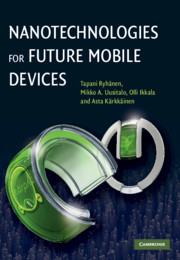Book contents
- Frontmatter
- Contents
- List of contributors
- Preface
- 1 When everything is connected
- 2 On the possible developments for the structural materials relevant for future mobile devices
- 3 Energy and power
- 4 Computing and information storage solutions
- 5 Sensing, actuation, and interaction
- 6 Future of Radio and Communication
- 7 Flat panel displays
- 8 Manufacturing and open innovation
- 9 Seeing beyond the hype: what the Internet teaches us about the development of nanotechnology
- 10 Conclusions
- Index
Preface
Published online by Cambridge University Press: 05 July 2014
- Frontmatter
- Contents
- List of contributors
- Preface
- 1 When everything is connected
- 2 On the possible developments for the structural materials relevant for future mobile devices
- 3 Energy and power
- 4 Computing and information storage solutions
- 5 Sensing, actuation, and interaction
- 6 Future of Radio and Communication
- 7 Flat panel displays
- 8 Manufacturing and open innovation
- 9 Seeing beyond the hype: what the Internet teaches us about the development of nanotechnology
- 10 Conclusions
- Index
Summary
Human culture is simultaneously extending its capabilities to master the physical world at its molecular scale and to connect people, businesses, information, and things globally, locally, and pervasively in real time. Nanotechnologies, mobile communication, and the Internet have had a disruptive impact on our economies and everyday lives. Nanotechnologies enable us to use physical, chemical, and biological processes to create new functional materials, nanoscale components, and systems. This book explains how these technologies are related to each other, how nanotechnologies can be used to extend the use of mobile communication and the Internet, and how nanotechnologies may transform future manufacturing and value networks.
At the beginning of 2007, the University of Cambridge, Helsinki University of Technology, and Nokia Research Center established a collaboration in nanotechnology research according to open innovation principles. The target has been to develop concrete, tangible technologies for future mobile devices and also to explore nanotechnologies in order to understand their impact in the bigger picture. The collaboration is based on joint research teams and joint decision making. We believe that this is the proper way to build a solid foundation for future mobile communication technologies. The book is based on the visions of researchers from both academia and industry.
During the summer of 2007 a team of researchers and industrial designers from the University of Cambridge and Nokia created a new mobile device concept called Morph. The Morph concept was launched alongside the “Design and The Elastic Mind” exhibition at the Museum of Modern Art (MOMA) in New York, has been featured in several other exhibitions, won a prestigious reddot design concept award, and has had considerable publicity – especially in the Internet.
Information
- Type
- Chapter
- Information
- Nanotechnologies for Future Mobile Devices , pp. xiii - xivPublisher: Cambridge University PressPrint publication year: 2010
